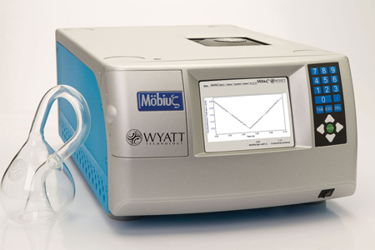Mobius™ Light Scattering Instrument

The finest, most versatile light scattering instrument for reliable electrophoretic mobility and size measurements of proteins, polymers, and all types of nanoparticles.
Non-destructive
Wyatt Technology's Mobius™ is the first and only light scattering instrument that makes reliable, reproducible, and non-destructive electrophoretic mobility measurements of macromolecules as small as 2 nm in radius (as well as micron-size nanoparticles) in most aqueous buffers. It is also Wyatt's best-performing detector for nanoparticle size analysis by means of batch dynamic light scattering.
Compatible with DYNAMICS®
The Mobius is operated by DYNAMICS, our powerful software package for collecting, analyzing, and reporting batch dynamic light scattering and electrophoretic mobility measurements.
DYNAMICS is offered with a 21 CFR Part 11 compliant Security Pack option, enabling the use of the DynaPro Plate Reader in a GMP environment.
Key benefits
The Mobius offers a unique suite of capabilities for mobility and size measurements of proteins, polymers and nanoparticles:
- Non-destructive analysis of fragile biomolecules
- Repeatable and accurate measurements in conductive buffers such as physiological saline
- Simultaneous measurements of size and mobility
- Automated sample handling or manual measurements
- Fluorescence blocking filter for sizing of fluorescing nanoparticles such as quantum dots
The Mobius characterizes the mobility of proteins and other biomolecules non-destructively and robustly, thanks to an innovative design enabling some unprecedented capabilities described more fully in the Advanced Technology tab.
Productivity, you say?
The Mobius features a novel, 170 µL flow cell providing advanced benefits, such as automated sample handling with a standard autosampler, to measure dozens of samples or conditions per day and maximize productivity. The high-pressure flow cell also affords connection to the Atlas™ pressurization system for robust and reproducible analysis of biomolecular mobility, net charge and zeta potential in solvents with conductivity up to 100 mS/cm - about 6x physiological saline.
The combination of mobility + size results in a calculation of the nanoparticle's zeta potential or the protein's net charge. Thanks to simultaneous dynamic light scattering analysis of molecular/nanoparticle size alongside the mobility measurement, you can monitor changes to the sample in real time and adjust measurement parameters as necessary.
The closed, PEEK flow cell also means compatibility with a wide range of volatile organic solvents.
